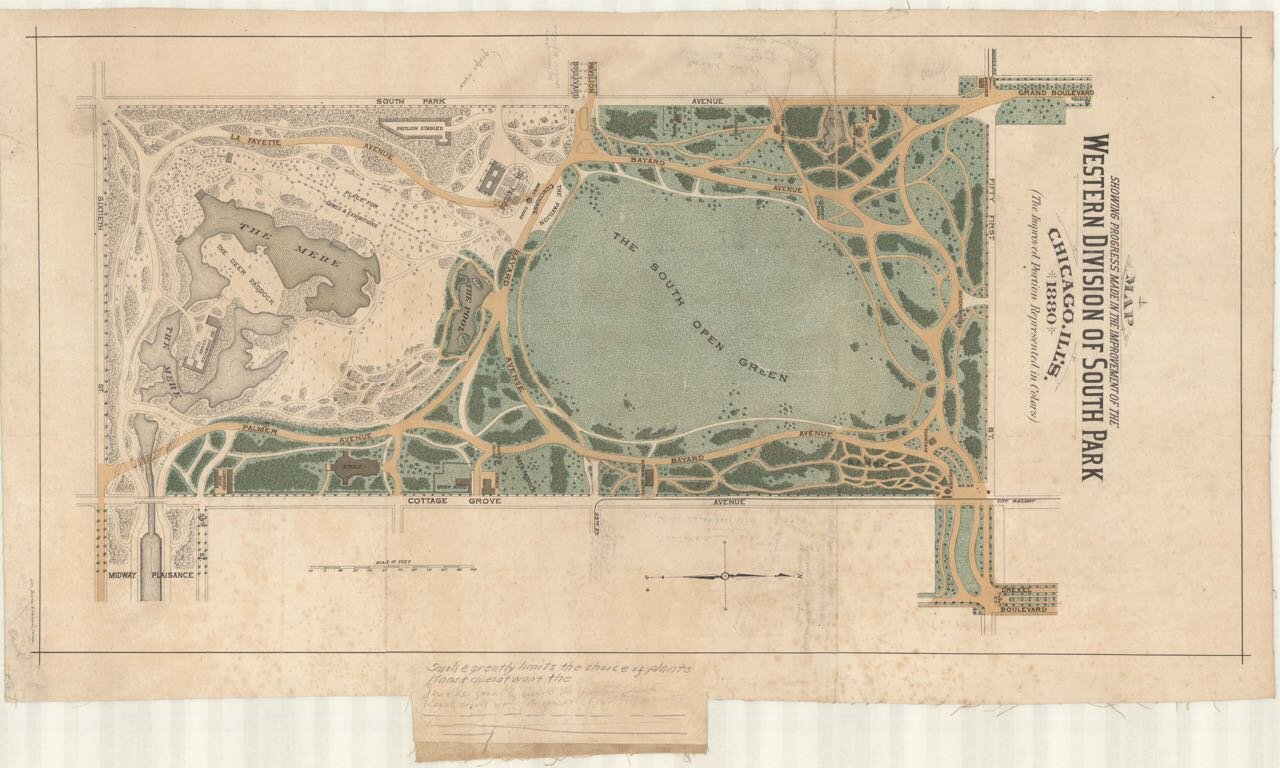Architect’s Statement on Proposed Alternate Plan for the Obama Presidential Center
Spend thirty minutes to an hour on Chicago’s storied South Side, and opinions will vary: Some will exclaim with wide eyes that the glass is half full; others will suggest ruefully that it is already half-empty. Regardless of one’s outlook, not even a perfect stranger would mistakenly claim the South Side lacks available space or potential. For this famous place, the Harlem of interior America, the Black Metropolis, beacon of the North, rich with architecture, mature green space, and history, has for too long suffered the compounding tragedies of systemic racism, depleted investment, disjointed and careless city planning, and social strife. Dereliction, decay, and emptiness are as prevalent today, if not more so, than they were at the beginning of the Urban Renewal period in the early 1940s, intensive community efforts to the contrary notwithstanding.
View of proposed site of the Obama Presidential Center
This storied land, which served as the home for such diverse talents as Lorraine Hansberry, Sun Ra, Muhammad Ali, Mies van der Rohe, Lou Rawls, the Marx Brothers, Ahmad Jamal, Kanye West, and Enrico Fermi, has historically been seen as a springboard to greatness. Regrettably, however, few of the notable figures having rocketed to international acclaim return home to reinvest in their community. Today even the South Side’s reputation as a fertile and promising land has suffered, with a staggering loss of over three-hundred thousand Black residents (40.9%) between 1980 and 2017, a disturbing trend that continues unabated. It can therefore stir no wonder that Chicagoans celebrated with giddy, somewhat exasperated relief when the South Side’s most famous family, Mr. and Mrs. Barack Obama, announced Chicago would be the home of their Obama Presidential Center.
As a key cultural institution, epicenter of rebirth, and monument to the nation’s first Black President, the Obama Presidential Center doubtless holds a singular importance to Chicagoans and to the future of the South Side. However, tragically, the current designs serve only as a perpetuation of the planning fiascos of the past, failing to position the Center and its community for long-term success.
Photo: Courtesy of the National Park Service, Frederick Law Olmsted National Historic Site
The current plans call for seizing acres of mature parkland in one of America’s most precious public landscapes, Frederick Law Olmsted’s Jackson Park. This shocking development is clearly a continuation of an engrained Urban Renewal mentality, where public and private property are taken without sufficient care for existing residents, and bulldozed unceremoniously without concern for historic context. This, and the disinterested, destructive, disaffecting processes by which it is engendered, have a proven track record of failure as they relate to both community stabilization and institutional longevity. For, what fool cares to invest his savings in the future of a community without permanence or predictability, where political whim can wipe away a life’s memories in seconds, where public assets are discreetly handed to wealthy, private institutions for as little as ten dollars?
Aside from the beautiful setting that will be decimated, the Jackson Park location offers little to the future OPC, being neither urban, nor central, nor easily accessed, nor strategically located in Chicago’s South Side community. Further, in a vain attempt to mitigate the irrefutable damage eventuated by the parkland location, the proposed Center’s architecture subverts and indeed neuters the activities of the Obama Foundation it purports to serve: the key activities in the building are either buried below-grade, tucked away invisibly into the landscape, or entombed in foreboding cliffs of stone. What should be a celebratory, engaging, vital, and essential contributor to the South Side – a dynamo of promise, and tangible engine of rebirth for our community – instead has been subjugated and entrapped by a dismal selection of site.
Make no mistake: The Obama Presidential Center, both as a symbol and as a perpetual living entity on Chicago’s South Side, can be a gift to all Chicagoans. And there should be no doubt that the South Side of Chicago, for all its beauty, richness, and potential, can serve as the ideal site to memorialize President Barack Obama, the man who captivated a nation by reminding us how to hope and achieve our dreams. But there is no room for error. There can, and will only be, one President Obama, and the opportunity to host an institution with as much potential for positive impact as the Barack Obama Foundation happens only once in a generation.
To fully realize the potential of the Obama Presidential Center, both to meet the goals of President Obama and to bolster the community the Foundation serves, the brute hand of Urban Renewal and the planning disgraces of the past are wholly insufficient. A better site must be found, and a stronger, more sensitive vision must be crafted. Fortunately, with the proverbial glass referenced above half full, myriad sites are readily at-hand that do not require the misappropriation and destruction of public parkland.
Historic Washington Park is the other half of Olmsted’s grand South Park system and has been a touchstone for Chicago’s Black Community for over a century. On Dr. Martin Luther King Jr. Boulevard, aside this great space and adjacent to the University of Chicago’s burgeoning Arts Block, sits vacant land that is unparalleled as a site for the Obama Presidential Center. For the past year, Protect Our Parks and Grahm Balkany: Architect have been working jointly to conceptualize a superior alternative – one that aims to demonstrate how this location can uniquely bolster the mission of the Obama Presidential Center and properly situate it as the very epicenter of community activity on the South Side.
Historic Washington Park is the other half of Olmsted’s grand South Park system and has been a touchstone for Chicago’s Black Community for over a century.
Photo: Courtesy of the National Park Service, Frederick Law Olmsted National Historic Site
While physically connected by the Midway Plaisance and superficially similar, with each site being less than one mile from the University of Chicago’s main quadrangle, the contrasts between the two options could not be more jarring. Where the Jackson Park location usurps precious parkland and massacres mature trees, the Washington Park location enlarges the existing green by several acres and does nothing to damage Olmsted’s legacy. Where the Jackson Park location is likely to be accessed almost exclusively by vehicular traffic, the Washington Park location is situated in one of the most transit-rich corridors of North America, and directly interfaces with the CTA Green Line – in so doing, directly tapping into the bloodstream of the city. Where the Jackson Park location carelessly, deplorably severs the historic interconnectivity of Chicago’s famous boulevard system – first envisioned by Olmsted and then enlarged by Daniel Burnham to form the “Emerald Necklace” – the Washington Park location enhances and improves this indispensable asset. And perhaps most critically, where the Jackson Park location is curiously remote and can hardly be described as a part of any neighborhood, the Washington Park location is strategically situated dead-center in the cultural mélange of opportunities and challenges that characterize the South Side. To borrow a common expression, the Washington Park location is “in the mix.” That is, precisely where the Obama Presidential Center belongs and can have the most lasting impact.
Where the Jackson Park location usurps precious parkland and massacres mature trees, the proposed Washington Park location enlarges the existing green by several acres and does nothing to damage Olmsted’s legacy. In addition, the proposed site integrates into the neighborhood and makes use of 12.65 acres that at present is mostly vacant and only occupied by a gas station, a parking lot and a former service station.
Our concept and plans demonstrate far-reaching aspirations based on the potential of the Washington Park site and what the Obama Presidential Center could become, at this location, as a physical manifestation of the lasting brilliance and historic change embodied by the Obama legacy. They represent but one of virtually limitless configurations and programs that could be achieved, and have been developed to illustrate the vast possibilities the site affords. The goal has expressly not been to strictly mimic what is currently being considered. As such, our version would also require commitment and cooperation of the city government, the South Side community, the Obama Foundation, and the Obama Presidential Center’s affiliate institution, the University of Chicago. However, an integrated planning effort – one executed with sensitivity and care, to maximize resources, precisely targeting urban needs – is what success demands at this place and time. Anything else will sorely handicap the positive impact of this singular public-private investment.
Now is the time to retire the damaging, maligned, and demonstrably failed policies of the past, and engage in a better path that sets the South Side on a track for success. All residents of Illinois should demand as much. Honoring the legacy of President Barack Obama is worth the effort. The future of our cherished South Side community is worth the effort.
Grahm Balkany, AIA
Bronzeville, February 2021
Sources:
“Fact Sheet: Black Population Loss in Chicago”, Greater Cities Institute, Chicago: University of Illinois at Chicago, 2019, accessed February 19, 2021, https://greatcities.uic.edu/wp-content/uploads/2019/08/Black-Population-Loss-in-Chicago.pdf.
U.S. Census Bureau, 1980 Decennial Census.
U.S. Census Bureau, 2013-2017 American Community Survey.
Click here to download a presentation that includes several renderings.




